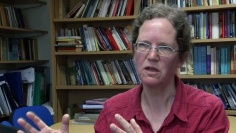LAURENCE REES: To what extent should we consider the Second World War as out of character with previous German history, or part of the whole process lasting back at least as far as the First World War, if not before?
MARY FULBROOK: Well, it’s both isn’t it? On the one hand it clearly is in some respects a continuation of the First World War and the tensions left to the legacies of the First World War. In another sense it really is wildly different right from the start, and I think that people often do not appreciate the extent to which the very beginning of the war already saw serious differences from any previous kind of war.
LAURENCE REES: And why was that?
MARY FULBROOK: If you look at the invasion of Poland in September 1939 you see in the very first week of the war the first mass atrocities against civilians, against Jewish women and children and old people. An awful lot is written about what happened after the invasion of the Soviet Union in the summer of 1941 in terms of Einsatzgruppen going in and atrocities being committed against civilians, but that was happening already in September 1939. If you take just the first week of the war and you look at Eastern Upper Silesia you get burnings of synagogues with people inside the synagogue dying in the flames. You get atrocities with the killing of men, women, children and old people in all the houses surrounding the synagogue in Będzin; this is a massive atrocity, the killing of civilians and no concept of reprisals in wartime. It’s not a military engagement it’s an atrocious ideological assault on ordinary Jewish people living in these areas.
LAURENCE REES: But it’s on nothing like the scale that it’s later to become.
MARY FULBROOK: That’s a different question entirely. I think when you look at the first four or five weeks of the war where the Einsatzgruppen in Poland are actually committing atrocities, I think it’s on a scale that we haven’t yet adequately registered. The secondary literature has not really picked up on the latest research on that. We’re not absolutely sure about numbers, the Einsatzgruppen reports themselves are very coy about numbers in some cases because there’s still a sort of sense that this isn’t quite legitimate, and, okay, we’re terrorising a population, but we’ve got to lay the blame on someone else, string up a few Polish Christians and say they were to blame for this not the Einsatzgruppen. So there’s a coyness about the reporting. But if you try and collate the evidence of eyewitnesses, of people who survived, of people who helped to rescue and so on, we’re talking at, just at Będzin on the 8th of September 1939, we’re talking about several hundred civilians being burnt alive or shot while they were trying to escape, or jumping into the river to put the flames out and being shot if they popped their heads out of the water for air. This is a massive atrocity and it’s the kind of thing that you get in the early summer of 1941 just after the invasion of the Soviet Union, the atrocities then are on that similar kind of small scale.
This is different from what happens later. It’s obviously smaller and it’s different in many respects but it is nevertheless an outrage which is not normal warfare and is not like the kinds of things that we saw with atrocities in the First World War, where there were atrocities but there was some kind of legitimation in military terms for them, in a way that there wasn’t here. This was racial.
LAURENCE REES: Of course the Freikorps committed terrible atrocities itself in the wars immediately after the First World War didn’t it, not necessarily of a dissimilar kind?
MARY FULBROOK: Yes, I think this is a very important point and I think this really keys into the debate about continuities in violence between the colonial wars of the early 20th Century and the atrocities in the First World War post-war period through to the Second World War. If you look at the Freikorps they clearly saw murder and violence as a legitimate political tool, but that was at a period when it was still up for grabs, it was societal violence, the State had not yet appropriated the monopoly of the means of violence. In the early 1920s, particularly in Eastern Upper Silesia, the Freikorps were marauding around all over the place engaged in battle. The Polish-German struggle in those borderlands was very vicious in the early 1920s and then just re-inflamed in 1939. But if you look at the difference, 1933 is quite a turning point because the State then monopolises the use of legitimate violence and unleashes it to a far greater extent after 1939. The Freikorps were just little units causing hundreds of deaths, but once you get to 1939 you’ve got the army and quite a different level of violence being employed.

AWARDS

Best in Class winner in both the Education and Reference categories at the 2011 Interactive Media Awards

Shortlisted in the Web Content Management category at the
2010 Econsultancy Innovation Awards
Highly Commended in the Digital Brand of the Year category at the 2010 PPA's Independent Publisher Awards

Nominated for Best Digital Solution of the Year (Consumer) at the 2010 International Customer Publishing Awards

Shortlisted in the Educational Entrepreneur category at the 2010 Digital Entrepreneur Awards
 Twitter
Twitter